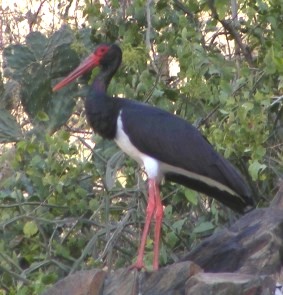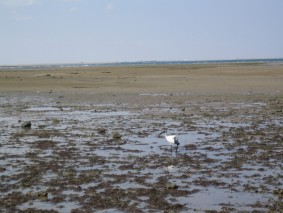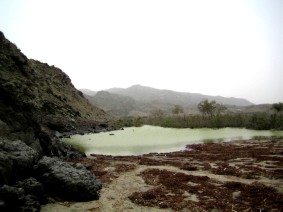|
Birdwatching in Eritrea Massawa and the Coastal Plains |
||
| Home |
Introduction Massawa is only 115 kilometres from Asmara, but the difference could not be greater. The habitat types on the coastal plains attract a completely different range of species, providing birdwatchers with a whole new experience. South of Massawa, around Foro there are areas of extensive acacia savannah, mangrove glades and volcanic lagoons around Erafile. North of Massawa this is replaced by semi-desert scrub and coastal dunes. Massawa lies along the Red Sea migration route, and significant numbers of Palearctic migrants winter along this stretch of coast, including one of the rarest birds in the world, the Northern Bald Ibis (Syrian breeding population).
Getting There The fastest way is to take the spectacularly scenic main road from Asmara to Massawa via Ghinda (a good place to stop for a few hours' birdwatching). It takes about two and a quarter hours. Alternatively, you could travel via the Filfil rainforest (see separate page: Filfil Birdwatching), where you would be well advised to stay for a day or two. Either way, the roads are surfaced and the views are incredible. Once you get to Massawa, stay on the same main road to get to the causeway that leads to the two islands (Taulud Island and Port Island), where most of the best accommodation is located.
Accommodation in Massawa On Taulud Island: Central Hotel is the most expensive, and probably the best hotel on Taulud. To get there, cross the causeway from the mainland and continue straight on until you get to the Tank Monument. Turn left here and the Central soon appears on your right. Prices are over 200Nfa. per room. Air conditioning. Telephone: 552002 Corrallo Hotel has nice views across the harbour. To get there go across the causeway and continue straight on, turning left at Edna Mariam Church. Rooms vary from 100 to 300Nfa. Telephone: 552406 Luna Hotel is a little cheaper than the Corrallo, and is located half way between the Corrallo and the Dahlak. Rooms are 80-200Nfa. Air conditioning or fans. Telephone: 552272 On Gurgussum Beach: Gurgussum Beach Hotel. As Gurgussum beach has some of the best birdwatching in the area, it's a good idea to spend a night at the hotel there, which is one of the best on the coast. At dusk and dawn you can go birdwatching along the beach. Prices vary from 180 to 500Nfa. The beach is also sandy and good for the family. Air conditioning. Tel: 552911
Habitat Types Sandy beaches. Rocky beaches. Mangrove. Coastal scrub. Coastal sand dunes. Salt pans. Semi-arid and arid desert. Acacia woodland. Irrigated agricultural land. Dry riparian woodland.
Birdwatching Highlights of Massawa and the Coastal Plains Gurgussum beach attracts a formidable range of waders and shorebirds, right next to the resort, especially during migration seasons (October-November and February-April). The mangroves on Green Island and further south in the Gulf of Zula attract several specialist species including the rare White-collared Kingfisher, Crab Plover and Blue-cheeked Bee-eater. The coastal plains south of Foro have good quality acacia woodland and during the coastal rainy season (November to March) you can find a wide range of species here including Ostrich and Arabian Bustard.
Where to Watch Birds
Massawa
Gurgussum
Beach Gurgussum Beach is about 10km north of Massawa. There is only one tarmac road that runs up there, and there areseveral hotels, popular with families from Asmara in the area. You can take a taxi (300Nfa) or a minibus (20Nfa) from Massawa town centre (on the mainland by the causeway) to get there. If you arrive at Gurgussum Beach Hotel, walk north to get away from the crowds and towards slightly rockier shores, and the birds will soon appear before you! About 4 kilometres further north, just behind a tiny pocket of mangrove there are several lagoons that collect water during the rainy season (November to April) and can have large numbers of waders, wildfowl and other waterbirds, especially during migration peaks. Birds: Brown Booby, Little Grebe, Great White Pelican, Pink-backed Pelican, Green-backed Heron, Western Reef Egret, Grey Heron, Goliath Heron, Abdim's Stork, Sacred Ibis, Eurasian Spoonbill, African Spoonbill, Shoveler, Tufted Duck, Teal, Pintail, Black Kite, Yellow-billed Kite, Osprey, Common Kestrel, Crab Plover, Eurasian Oystercatcher, Avocet, Black-winged Stilt, Ringed Plover, Three-banded Plover, Kentish Plover, Lesser Sand Plover, Greater Sand Plover, Grey Plover, Sanderling, Curlew Sandpiper, Dunlin, Bar-tailed Godwit, Black-tailed Godwit, Whimbrel, Curlew, Greenshank, Common Redshank, Spotted Redshank, Wood Sandpiper, Marsh Sandpiper, Terek Sandpiper, Common Sandpiper, Ruddy Turnstone, Sooty Gull, White-eyed Gull, Common Black-headed Gull, Slender-billed Gull, Lesser Black-backed Gull, Heuglin's Gull, Yellow-legged Gull, Gull-billed Tern, Caspian Tern, Greater Crested Tern, Lesser Crested Tern, Sandwich Tern, Common Tern, White-cheeked Tern, Saunders's Tern, African Palm Swift, Crested Lark, Black-crowned Sparrow Lark, Black Scrub Robin, Desert Wheatear, Graceful Prinia, Yellow Wagtail, White Wagtail, Isabelline Wheatear, House Crow, Village Weaver
Green Island (Sheikh Said Island) This is the only island close enough to visit on a day trip from Massawa. It is small, and occasional tourist boats come here, but there is still plenty of mangrove on the island and good numbers of waterbirds roost and nest here including Sacred Ibis, Little and Cattle Egret. You can also find White-collared Kingfisher here and Brown Booby sometimes visit the island. Large numbers of Sacred Ibis breed here during the winter.1 Birds: Brown Booby, Pink-backed Pelican, Greater Flamingo, Striated Heron, Western Reef Egret, Grey Heron, Purple Heron, Greater Flamingo, Pink-backed Pelican, Abdim's Stork, Sacred Ibis, Osprey, Senegal Thick-knee, Crab Plover, Ruddy Turnstone, Ringed Plover, Grey Plover, Three-banded Plover, Kentish Plover, Lesser Sand Plover, Greater Sand Plover, Curlew, Whimbrel, Greenshank, Common Sandpiper, Dunlin, Redshank, Little Stint, Terek Sandpiper, Slender-billed Gull, Sooty Gull, Common Black-headed Gull, Lesser Black-backed Gull, Heuglin's Gull, Common Tern, Caspian Tern, Greater Crested Tern, Lesser Crested Tern, Gull-billed Tern, Saunders's Tern, White-collared Kingfisher, Eurasian Reed Warbler, Graceful Prinia
Foro,
Adulis and Eraflie If you have the time and the opportunity to explore south of Massawa, there are a wealth of habitat types in this area. In order to get to the area, you should apply for a travel permit to visit Adulis, a famous archaelogical site. Such a permit will allow you to get to Foro, and you can also explore south down to Erafile. Between Foro and Erafile there is some good acacia savannah, coastal scrub, and also plenty of undisturbed mangroves, where Dugong can sometimes be seen. At Erafile, there are several dormant volcanoes, some hot springs, and a few kilometres past the village along the road south east there is an isolated bay with a lagoon that is good for a variety of waders, waterbirds and migrants. I'd recommend spending a day or two birdwatching in the area. Foro doesn't have many good hotels, but you can easily drive down from Massawa in an hour or so. The following locations will produce a good variety of species: Adulis archaelogical site - Coastal scrub; good for migrant passerines and resident warbler species. Rubruria - at the mouth of the Ruba Hadas, there is lots of irrigated agricultural land around here, providing habitat for wintering Palearctic migrants, passage migrants and certain resident species that are attracted to the greener vegetation. Acacia savannah - 20km south of Foro; this is some of the best acacia savannah on the coastal plains. During the winter months a good variety of species can be seen here, including Ostrich and Arabian Bustard. Coastal mangrove - 25km south of Foro; the mangrove can be seen from the road 10-15km before you get to Erafile. This is a quiet stretch of coast, and will provide a good variety of species, including shorebirds, mangrove specialists and passage migrants. Beware of Dengue Fever mosquitoes here; unlike Malaria mosquitoes they are active by day, so cover up exposed skin and wear repellent while you're in the mangroves. Erafile volcanic lagoon - a few kilometres south-east of Erafile a coastal lagoon behind a sand bar will come into view of the road. Park nearby and explore. Often there are lots of Greater Flamingos and shore birds in the area. Birds: Brown
Booby, Greater Flamingo, Green-backed Heron, Yellow-billed Egret, Grey
Heron, Abdim's Stork, Little Egret, Sacred Ibis, Eurasian Spoonbill, Osprey, Yellow-billed Kite, Montagu's
Harrier, Common Kestrel, Common Quail, Crab Plover, Grey Plover,
Three-banded Plover, Ringed Plover, Little Ringed Plover, Redshank, Little
Stint, Kentish Plover, Black-tailed Godwit, Curlew, Greenshank,
Black-headed Gull, Caspian Tern, Chestnut-bellied Sandgrouse, Cape Turtle
Dove, Namaqua Dove, African Grey Hornbill, White-browed Coucal, Little
Green Bee-eater, Blue-cheeked Bee-eater, Malachite Kingfisher,
White-collared Kingfisher, Yellow-breasted Barbet, Eurasian Hoopoe,
Crested Lark, Black-crowned Sparrowlark, House Martin, Barn Swallow, Red-rumped
Swallow, White Wagtail, Yellow Wagtail, Grey Wagtail, House Crow, Pied
Crow, Black Scrub Robin, Rufous-tailed Scrub Robin, Stonechat,
Isabelline Wheatear, Menetrie's Warbler, Graceful Prinia, Southern Grey
Shrike, Red-tailed Shrike, Chestnut-bellied Starling, Red-billed Oxpecker,
House Sparrow, Baglafecht Weaver, Cinereous Bunting
Reference 1) The Status of Breeding Seabirds and Waterbirds on the Eritrean Red Sea Islands (Dawit Semere, Tewolde Hagos, Ghebrezghi Seleba, Yossief Gebrezgabhier, Zeweldi Haile, Giorgio Chiozzi and Giuseppe De Marchi) Bulletin of the African Bird Club, Vol 15, no 2, September 2008 |
|
| Eritrea Information | ||
| Abyssinian Endemics | ||
| Bird Checklist for Eritrea | ||
| Travel & Accommodation | ||
| In Italiano | ||
| Photos | ||
| Other Wildlife | ||
| Asmara Birdwatching | ||
| Filfil Birdwatching | ||
| Adi Keih Birdwatching | ||
| Massawa Birdwatching | ||
| Dahlak Islands Birdwatching | ||
| Elabered / Keren Birdwatching | ||
| Gash Barka Birdwatching | ||
| Contacts and Services | ||
| Links | ||
| Children and Schools | ||
|
|
||
|
|
||

 and Lagoons
and Lagoons - the Gulf of Zula
- the Gulf of Zula